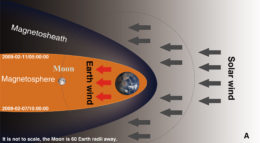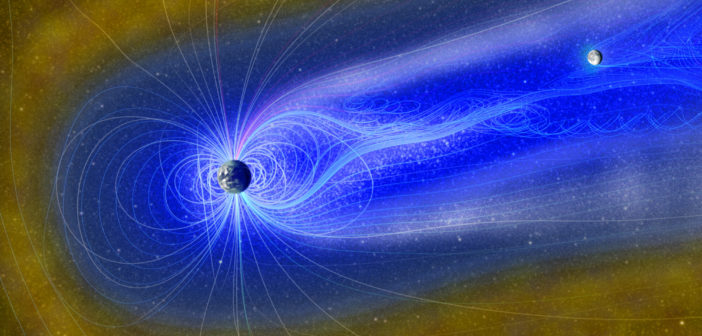Given plans for future manned missions to the Moon — and interest in the potential for longer-term lunar habitation — the presence of water on the Moon is of critical importance. Studies over the last few decades have revealed water lurking on our satellite in numerous forms. But how does it get there?
Water In, Water Out

Overview of the lunar OH/H2 abundance in the polar regions of the Moon, as derived from M3 observations in January/February 2009. [Adapted from Wang et al. 2021]
But lunar water is more complicated than its mere presence or absence. The Moon is also thought to have a water cycle — water is continuously created on or delivered to the Moon’s surface, and then destroyed on or removed from it.
Understanding the driving processes in this cycle will enable us to best leverage the Moon’s resources and deepen our insight into the physics that influences airless rocky bodies throughout our solar system and beyond.
Identifying Processes
Based on laboratory experiments and lunar observations, here’s our understanding so far:
- Production
We think the continuous production of lunar surface water may largely be driven by incoming protons — hydrogen nuclei — from the solar wind, which then bind with the oxygen in lunar minerals to form water. Other processes may also contribute, like production from additional sources of incoming protons, or episodic delivery of water via comets and asteroids. - Removal
Water on the Moon’s surface is primarily removed through continuous processes like photodissociation — the decomposition of water molecules by sunlight.
With the rich observations recently produced by missions like NASA’s Moon Mineralogy Mapper (M3) spectrometer on India’s Chandrayaan-1 orbiting probe, we’re currently in an excellent position to test this understanding.
In a new publication led by Huizi Wang (Shandong University and Chinese Academy of Sciences), a joint team of space physicists and planetary scientists presents an exploration of water production on the surface of the Moon.
Windy Production

Schematic showing the Moon’s orbit around the Earth. The Moon spends 3–5 days each orbit passing through the Earth’s magnetosphere, where it is shielded from the solar wind. [Adapted from Wang et al. 2021]
Instead, the authors find that spectroscopy from M3 reveals no change in water abundances over the complete lunar orbit, despite observations showing the expected drop in incoming solar wind energy when the Moon passes through Earth’s magnetosphere.
Could another source contribute to production of water on the Moon, keeping abundances constant? Wang and collaborators demonstrate that when the Moon is shielded from the solar wind, incoming protons from the Earth’s wind — a weaker stream of charged particles from the Earth’s magnetosphere — could provide the protons needed to maintain observed water abundances on the Moon’s surface.
There are still many open questions, but the future holds more opportunities to refine our understanding. The Chinese Chang’e 5 lunar mission successfully measured lunar material and brought samples back to Earth late last year, and the planned Artemis missions to the Moon will soon provide further insight.
Citation
“Earth Wind as a Possible Exogenous Source of Lunar Surface Hydration,” H. Z. Wang et al 2021 ApJL 907 L32. doi:10.3847/2041-8213/abd559

